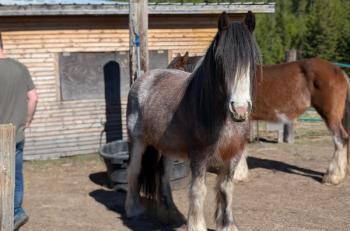
MRLS: 'Reasonable control' strategies urged to guard against caterpillar threat
There are no signs this Spring of widespread high populations of eastern tent caterpillar (ETC) – the insect linked to Mare Reproductive Loss Syndrome (MRLS) – but horse farms still should take precautionary measures, says Lee Townsend, PhD, entomologist at the University of Kentucky College of Agriculture.
There are no signs this Spring of widespread high populations of eastern tent caterpillar (ETC) – the insect linked to Mare Reproductive Loss Syndrome (MRLS) – but horse farms still should take precautionary measures, says Lee Townsend, PhD, entomologist at the University of Kentucky College of Agriculture.
The Gluck Equine Research Center, part of the university's Department of Veterinary Science, urged area farms to implement reasonable control strategies to maintain good ETC control.
Townsend recommends spraying trees with bifenthrin and carbaryl, and urges farms to "scout for the tell-tale white tents in cherry and crabapple trees. Err on the side of caution by keeping mares away from any caterpillar locations," he says.
A watch for forest-tent caterpillars, which are assumed to similarly affect horses, was suggested along the Ohio River and in Boone County, Ky. The pest is not usually active in central Kentucky.
Table 1
After major MRLS outbreaks in 2001 and 2002, research showed the relationship between the MRLS pathology and massive ETC infestations in black-cherry trees that lined equine pastures. The caterpillars, consumed by mares and their setae embedded in the intestine, were found to initiate GI infection, which transmitted normal alimentary bacteria to the mare reproductive tract. That in turn reduced immunity and caused abortions and other pathology.
MRLS is characterized by early fetal loss – within 35 to 100 days after mares are bred – followed by expulsion of the fetus. It is associated with the presence of echogenic fluid (cloudy and flocculent) around the fetus.
Late fetal loss, during the last trimester of pregnancy, is characterized in many cases by an engorged placenta (red bag condition); foals born alive but weak and requiring intensive care. Besides reproductive losses, cases of pericarditis and uveitis were reported.
The 2001 and 2002 outbreaks had a devastating impact on Kentucky's Thoroughbred breeding industry, resulting in losses of thousands of foals in several breeds, with an economic value of more than $336 million. An estimated 30 percent of foals were lost in 2001 alone.
Clear and present danger: An example of Eastern Tent Caterpillar infestation in Kentucky.
Ed Kane is a Seattle author, researcher and consultant in animal nutrition, physiology and veterinary medicine, with a background in horses, pets and livestock.
Newsletter
From exam room tips to practice management insights, get trusted veterinary news delivered straight to your inbox—subscribe to dvm360.






